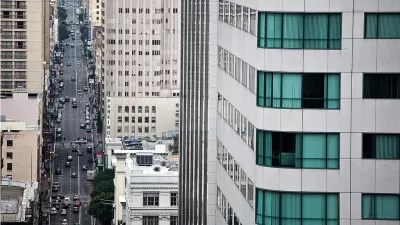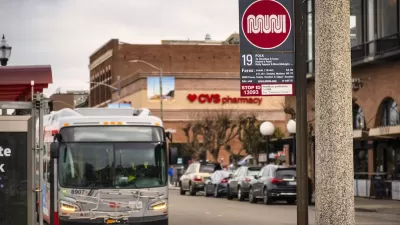Facing record-level population growth and a booming job market, the city of San Francisco wants luxury developers to pay into the public transit system.

San Francisco faces a dilemma. In recent decades, population growth has far outpaced residential housing construction, creating a housing shortage for both affordable and market-rate units. The booming job market has added to the influx of commuters, overburdening an aging public transit system. The city wants to continue its program of encouraging new housing construction, but it also must find a way to mitigate the impact that growing congestion has on the transit system. Until now, downtown luxury high-rises have benefited from a multi-modal location without paying for it. "A luxury tower could advertise transit access as a perk, then dump all these new residents onto a bus and rail system that was already overloaded," writes Eric Jaffe.
To address the growing gap between population and transit capacity, the city has proposed that existing transit impact development fees be extended to market-rate residential developers. The fee proposal is part of a broader Transportation Sustainability campaign by the Planning Department: "If we don’t change our development practices and invest in transportation improvements citywide, we can expect unprecedented gridlock on our streets and crowding on our buses and trains."
But how much the fee should be is up for debate. Given the need to incentivize new construction, provide more affordable housing, and maintain a robust and reliable transit system, is the proposed fee structure effective? "The fee was set by determining how much development impacts transit in terms of cost, roughly $31 per square foot, then balancing it with the results of a fiscal feasibility study that looked at what level a fee would discourage development," writes Cory Weinberg.
Currently, such fees are paid by commercial builders, and annual revenue streams average $24 million. The new fee structure would increase that amount by 40 percent. According to Weinberg: non-residential developers would see an increase from $14 a square foot to $18.04 a square foot; the manufacturing sector (also a growth target for the city) would see only a minor fee increase, from $7.46 to $7.61 a square foot; and the newly added market-rate residential fee would be $7.74 a square foot.
A previous attempt to impose a transit impact fee on residential development was shot down because it also targeted non-profits, medical centers and affordable housing units. The new proposal exempts these groups as well as builders with less than 20 housing units.
The fact that developers are on board with the new proposal suggests that it will still be very profitable to build luxury condos in San Francisco. "Developer acceptance is great for the plan, but it does raise the question of whether the 'not unreasonable' fee might, in fact, be a bit too reasonable," says Jaffe.
FULL STORY: San Francisco's Humble Request to Luxury Developers: Pitch in for Public Transit

Alabama: Trump Terminates Settlements for Black Communities Harmed By Raw Sewage
Trump deemed the landmark civil rights agreement “illegal DEI and environmental justice policy.”

Study: Maui’s Plan to Convert Vacation Rentals to Long-Term Housing Could Cause Nearly $1 Billion Economic Loss
The plan would reduce visitor accommodation by 25% resulting in 1,900 jobs lost.

Why Should We Subsidize Public Transportation?
Many public transit agencies face financial stress due to rising costs, declining fare revenue, and declining subsidies. Transit advocates must provide a strong business case for increasing public transit funding.

Paris Bike Boom Leads to Steep Drop in Air Pollution
The French city’s air quality has improved dramatically in the past 20 years, coinciding with a growth in cycling.

Why Housing Costs More to Build in California Than in Texas
Hard costs like labor and materials combined with ‘soft’ costs such as permitting make building in the San Francisco Bay Area almost three times as costly as in Texas cities.

San Diego County Sees a Rise in Urban Coyotes
San Diego County experiences a rise in urban coyotes, as sightings become prevalent throughout its urban neighbourhoods and surrounding areas.
Urban Design for Planners 1: Software Tools
This six-course series explores essential urban design concepts using open source software and equips planners with the tools they need to participate fully in the urban design process.
Planning for Universal Design
Learn the tools for implementing Universal Design in planning regulations.
Smith Gee Studio
Alamo Area Metropolitan Planning Organization
City of Santa Clarita
Institute for Housing and Urban Development Studies (IHS)
City of Grandview
Harvard GSD Executive Education
Toledo-Lucas County Plan Commissions
Salt Lake City
NYU Wagner Graduate School of Public Service





























